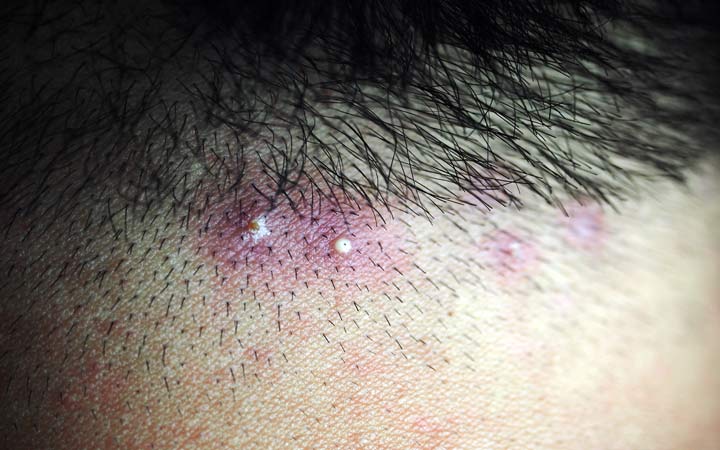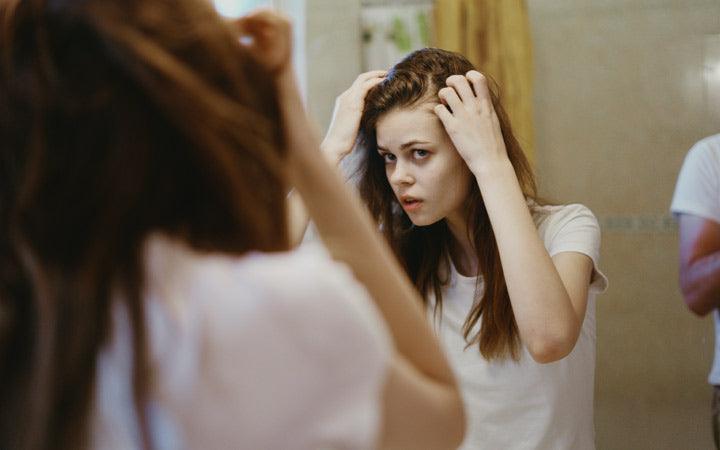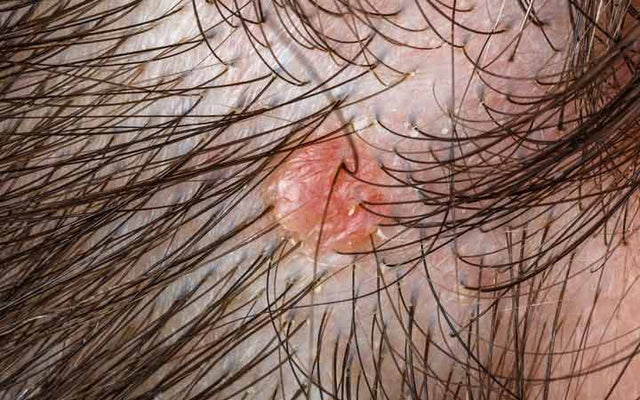Are those red bumps on your scalp bothering you? Does it feel like acne breakout on the scalp? If yes, it could be the cause of a common skin condition called scalp folliculitis.
In this article, we discuss everything you need to know about scalp folliculitis and how you can help treat and manage it effectively. Read on to find out more.
What Expert Says
“Severe scalp folliculitis definitely needs medical attention. It has multiple etiologies. It is better to avoid harsh shampoos while cleansing hair to reduce aggravation.”
Dr.Harish Koutam, Chief Dermatologist, SkinKraft
Highlights:
- What Is Scalp Folliculitis?
- What Does Scalp Folliculitis Look Like?
- Symptoms Of Scalp Folliculitis
- Types Of Scalp Folliculitis
- How Is Scalp Folliculitis Diagnosed?
- What Causes Folliculitis On The Scalp?
- How Do You Treat Scalp Folliculitis?
- How Long Does Scalp Folliculitis Last?
- Who's At Risk Of Scalp Folliculitis?
- Prevention Tips For Scalp Folliculitis
- How Can You Tell If Folliculitis Is Bacterial Or Fungal?
- What Happens If Folliculitis Goes Untreated?
What Is Scalp Folliculitis?
This is an inflammatory disorder that affects the hair follicles in the scalp. The hair follicles on your scalp become inflamed or irritated. The skin condition is characterized by small and itchy pustules on the scalp, often most bothersome on the frontal hairline. These bumps may vary in size and severity from person to person. Bacteria, yeast infection, ingrown hair and other reasons could be the contributing factors for scalp folliculitis.
While the condition isn’t life-threatening, it can be itchy, painful and embarrassing. However, with your doctor’s timely intervention, you can get rid of it.
What Does Scalp Folliculitis Look Like?

Scalp folliculitis usually looks like clusters of small red bumps and can initially be mistaken for an acne breakout.
If left untreated, folliculitis can spread to other hair follicles, and the bumps may get more inflamed. You may also get blisters that break open, ooze pus and turn crusty.
Symptoms Of Scalp Folliculitis

- Clusters of small red bumps
- White heads on some of the bumps
- Burning or stinging sensation
- Pain or tenderness
- Itchiness
- Sores
- Pus-filled blisters

Types Of Scalp Folliculitis
Folliculitis is broadly classified as superficial and deep. While superficial folliculitis is mild and easily treatable, deep folliculitis penetrates deeper into the hair follicle making it difficult to get rid of.
1. Superficial Folliculitis
A. Bacterial Folliculitis
This is a common bacterial infection of the follicles. The bacteria that live on the skin, enter the follicles through a cut or wound. Usually, it is staphylococcus aureus that attacks your follicles.
This is characterised by itchy, pus-filled bumps.
B. Pseudofolliculitis Barbae (PFB)
This is commonly known as razor bump or barber's itch. Reportedly, it affects almost 60 [1] percent African American men and people with curly hair.
It is caused due to ingrown hair. A 100 [2] percent effective treatment is to allow the hair to grow before shaving them. Avoiding a shave for 3-4 weeks is often helpful.
C. Pseudomonas Folliculitis
This is also known as hot tub folliculitis. It occurs due to using unclean pools or hot tubs and usually affects the areas covered with a swimsuit or at the back of the legs. Especially, when the pH level or chlorine level is not balanced, hot tub folliculitis are more likely to happen.
You can notice symptoms within 72 hours of exposure.
D. Pityrosporum Folliculitis
This is a yeast infection of the skin that leads to redness and itchiness. It usually occurs in the face and upper body. This type of folliculitis is more prevalent in young adults.
2. Deep Folliculitis
A. Boils & Carbuncles
A bacterial infection that occurs deep inside the follicles can lead to painful, pus-filled boils.
They grow in size due to pus accumulation until they rupture and drain. Scarring may develop as an aftereffect of boils. Carbuncles happen when several boils appear on the same spot.
B. Sycosis Barbae
This is similar to a razor bump but is deeper. It can cause serious scarring on your scalp in some cases.
C. Eosinophilic Folliculitis
This is an intense and repetitive occurrence of folliculitis, often leading to dark patches of skin.
People who have weak immunity are more prone to develop this.
D. Gram-Negative Folliculitis
People on antibiotics for long durations are at risk of developing this form of folliculitis.
Long-acting antibiotics disrupt the normal bacterial balance of the skin.
How Is Scalp Folliculitis Diagnosed?
Your doctor can diagnose folliculitis by examining your skin and asking you a few questions about your medical history.
In most cases, a lab test is not required to diagnose folliculitis. However, if needed, your doctor might take a swab of the affected area to analyze its root cause.
What Causes Folliculitis On The Scalp?

Folliculitis on the scalp may develop if hair follicles are damaged. This can happen due to several factors, such as:
- Wearing helmets for a long time
- Shaving your head
- Wearing your hair too tight in ponytails or braids
- Frequently scratching your scalp
- Using too many hair products, which can clog your follicles over time
- Weak immune system
- Yeast infection
- Bacterial infection
- Long-term application of topical antibiotics
- Using unchlorinated water in a hot tub or being in unclean water for a long time
- Consumption of few drugs such as corticosteroid
How Do You Treat Scalp Folliculitis?
1. Topical Antibiotics
You can clean the affected area with an antibacterial cleanser [3] to limit the spread of folliculitis. The topical application of antibiotics can also help reduce the itch.
Common topical antibiotics that work for scalp folliculitis include fusidic acid gel, clindamycin, and erythromycin
2. Steroid Lotions, Creams, Soaps
For mild infections, your doctor may prescribe steroid lotions, creams, and soaps. A medicated shampoo [4] may also be prescribed to treat folliculitis of the scalp or beard.
While choosing a shampoo, it is advisable to pick an anti-dandruff formula that contains ingredients such as tea tree oil, ketoconazole, or ciclopirox.
Applying Cortisone cream or Neosporin ointment may also provide some relief.
3. Oral Medications
Oral medications are not necessarily prescribed by doctors for routine treatments. However, if your case is severe, or if your infection is recurring, your doctor might prescribe oral antibiotics.
4. Home Remedies
The first step to treat folliculitis at home is to find its root cause. Be mindful of your habits. For instance, if you shave your head frequently, try to maintain a gap of at least three to four weeks between each shave.
Other home remedies that may offer relief include:
A. Warm Compress
Wet a washcloth in warm water and place it on the affected area for a few minutes. Do this a few times in the day to soothe the area and reduce itching.
B. Herbs
Apply oatmeal on your scalp to reduce inflammation. A research study [5] reports that oatmeal has anti-inflammatory properties and can offer relief from various skin conditions.
Another study [6] revealed that the usage of traditional herbs helps reduce the symptoms of folliculitis in many cases.
C. Oils
Certain essential oils like lemon oil, eucalyptus oil, clove oil, tea tree oil, cinnamon oil, and chamomile oil have antibacterial and antifungal properties that can be effective in controlling folliculitis.
Dilute a few drops of essential oil of your choice with a carrier oil or moisturizer and apply locally to soothe itchiness.
How Long Does Scalp Folliculitis Last?
Folliculitis gets cured within 7-10 days without treatment. However, in some severe cases, it may cause permanent hair loss or scarring.
In general, folliculitis can be treated easily by a timely intervention by your doctor. According to our chief dermatologist, Dr. Harish Koutam, “Severe scalp folliculitis definitely needs medical attention. It has multiple etiologies. It is better to avoid harsh shampoos while cleansing hair to reduce aggravation.”
Who's At Risk Of Scalp Folliculitis?
Although anyone can develop folliculitis, certain pre-existing medical conditions may add to the risk factor. These include:
- Conditions like AIDS, leukemia, and diabetes reduce the body’s immunity
- Acne
- Pre-existing dermatitis
- Men with curly hair who shave frequently
- Wearing tight clothes or waxing can damage the
- Using public hot tubs and pools
- Taking long-term antibiotics
Prevention Tips For Scalp Folliculitis
You can prevent scalp folliculitis by following these simple guidelines:
- Bathe daily, especially after workouts
- Use a mild soap
- Don’t scratch the bumps
- Avoid shaving too frequently
- Avoid tying your hair too tight
- Avoid using too much oil as this can clog the follicles and trap bacteria
- Maintain personal hygiene. Do not share your towel, comb, or any other personal items
- Use only clean pools or hot tubs
Note:
You should consult your doctor to treat underlying medical conditions. Also, if you take any medication, find out whether the drugs could be further aggravating your folliculitis.
How Can You Tell If Folliculitis Is Bacterial Or Fungal?
Apart from examining your skin, your doctor may take a swab from the affected area to conclude whether it is a bacterial or fungal infection.
Performing a skin biopsy is a rare case. However, the doctor may perform one to rule out other probable causes.
What Happens If Folliculitis Goes Untreated?
A mild case of folliculitis usually heals on its own when left untreated.
Hot tub folliculitis may settle down within ten days [7] if left untreated.
Folliculitis barbae, when left untreated, can gradually progress and spread, causing a deep-seated infection known as sycosis barbae [8].

Wrapping Up
Folliculitis is a relatively common skin condition caused by inflammation and infection in the hair follicles.
Although a mild infection usually cures itself and can be treated at home, it is essential to consult with your doctor before deciding to use medication. Depending on your situation and frequency of recurrences, your doctor can suggest the right course of action.
1. https://www.aocd.org/page/PseudofolliculitisB
2. https://www.aocd.org/page/PseudofolliculitisB
3. https://my.clevelandclinic.org/health/diseases/17692-folliculitis#management-and-treatment
4. https://www.uofmhealth.org/health-library/hw171614
5. https://pubmed.ncbi.nlm.nih.gov/22421643/
6. https://onlinelibrary.wiley.com/doi/full/10.1111/bjd.13422
Recommended Products
Was this Article helpful?
- Least helpful
- Most helpful





